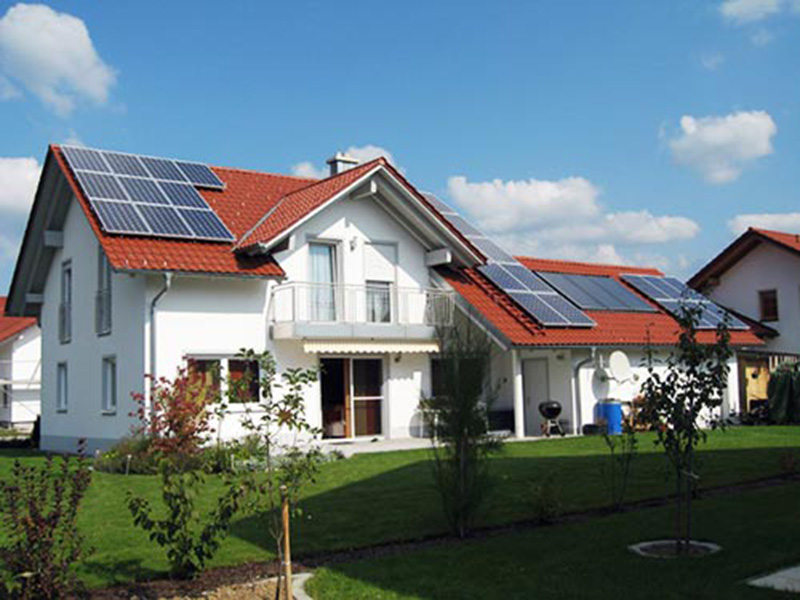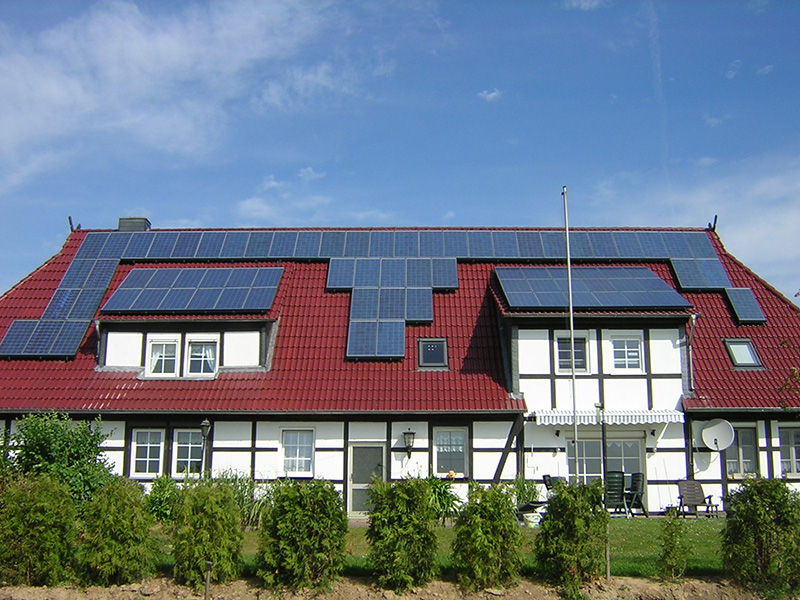Solar power systems are a concern for every PV EPC contractor. Optimizing the system first optimizes the micro-inverters on the PV modules because each PV module is equipped with a separate micro-inverter that allows the system to adapt to changing loads and Different weather conditions provide the best slow efficiency for a single component or even the entire system.
Micro-inverters also simplify wiring, which means lower installation costs. The ultimate goal of optimization is to make solar power systems more efficient, and the time it takes to recover the entire system is shorter.
The Sun can generate system
Power inverters are key electronic components of solar power systems. In commercial applications, these components connect photovoltaic (PV) panels, batteries that store electrical energy, and local power distribution systems or utility grids.
In a typical solar energy harvesting system, multiple solar panels are connected in parallel to an inverter that converts the variable DC output from multiple photovoltaic cells into a clean 50 Hz or 60 Hz sine wave inverter.
The main goal of the design is to maximize conversion efficiency. This is a complex and iterative process involving the Maximum Power Point Tracking Algorithm (MPPT) and a real-time controller that executes the associated algorithms.
1. Maximize power conversion efficiency
An inverter that does not use the MPPT algorithm simply connects the photovoltaic module directly to the battery, forcing the photovoltaic module to operate at the battery voltage. Almost without exception, battery voltage is not the ideal value for collecting the most available solar energy.
The solid line indicates the ratio of voltage to current (PV AMPS).
But with the MPPT algorithm, the situation has changed radically. In this example, the voltage at which the module can achieve maximum output power is 17V. Therefore, the MPPT algorithm's job is to operate the module at 17V, so that all 75W of power can be obtained from the module regardless of the battery voltage.
A high efficiency DC/DC power converter converts the 17V voltage at the controller input to the battery voltage at the output. Since the DC/DC converter reduces the voltage from 17V to 12V, in this example, the battery charging current in the system that supports the MPPT function is:
(VMODULE/VBATTERY) × IMODULE, or (17V/12V) × 4.45A = 6.30A.
Assuming that the conversion efficiency of the DC/DC converter is 100%, the charging current will increase by 1.85A (or 42%).
Although this example assumes that the inverter processes energy from a single solar panel, conventional systems typically have one inverter connected to multiple panels. This topology has both advantages and disadvantages depending on the application.
2.MPPT algorithm
There are three main types of MPPT algorithms: disturbance-observation, conductance increment, and constant voltage. The first two methods are often referred to as "climbing" because they are based on the following facts:
On the left side of the MPP, the curve is on the rise (dP/dV) 0), while on the right side of the MPP, the curve is down (dP/dV “0”).
The Disturbance-Observation (P&O) method is the most commonly used. The algorithm perturbs the operating voltage in a given direction and samples dP/dV. If dP/dV is positive, the algorithm "understands" that it was just adjusting the voltage towards the MPP. Then it will always adjust the voltage in this direction until dP/dV becomes negative.
P&O algorithms are easy to implement, but in steady-state operation they sometimes oscillate around the MPP. And their response speed is slow, and even in rapidly changing climatic conditions it is possible to reverse the direction.
The Conductance Increment (INC) method uses the conductance increment dI/dV of the PV array to calculate the positive and negative of dP/dV. INC can track rapidly changing light exposures more accurately than P&O. But like P&O, it can also oscillate and be "deceived" by rapidly changing atmospheric conditions. Another disadvantage is that the added complexity increases the computation time and reduces the sampling frequency.
The third method, “Constant Voltage Method”, is based on the following facts: In general, VMPP/VOC0.76. The problem with this method stems from the fact that it is necessary to instantaneously adjust the current of the photovoltaic array to zero to measure the open circuit voltage of the array. Then, the operating voltage of the array is set to 76% of the measured value. However, during the disconnection of the array, the available energy is wasted. It has also been found that although 76% of the open circuit voltage is a good approximation, it is not always consistent with MPP.
Since no MPPT algorithm can successfully meet all common usage requirements, many design engineers will let the system first evaluate the environmental conditions and then select the algorithm that best fits the current environmental conditions. In fact, there are many MPPT algorithms available, and it is not uncommon for solar panel manufacturers to provide their own algorithms.
For inexpensive controllers, in addition to the normal control functions of the MCU, executing the MPPT algorithm is no easy task. The algorithm requires these controllers to have superior computing power.
Advanced 32-bit real-time microcontrollers such as the Texas Instruments C2000 platform family are suitable for a variety of solar applications.
Solar power generation equipment
3. Power inverter
There are many benefits to using a single inverter, the most prominent of which is simplicity and low cost. The efficiency of the single inverter system is improved with the MPPT algorithm and other techniques, but only to a certain extent. The disadvantages of a single inverter topology can vary depending on the application. The most prominent is the reliability problem: as long as the inverter fails, the energy generated by all the panels is wasted before the inverter is repaired or replaced.
Even if the inverter is working properly, a single inverter topology can have a negative impact on system efficiency. In most cases, each solar panel has different control requirements for maximum efficiency. Factors that determine the efficiency of each panel are: differences in the manufacturing of the photovoltaic modules contained in the panel, different ambient temperatures, shadows, and azimuths of the different light intensities (the original solar energy received).
Having a micro-inverter for each solar panel in the system will again increase the conversion efficiency of the entire system compared to using an inverter for the entire system. The main benefit of the micro-inverter topology is that even if one of the inverters fails, the energy conversion can still take place.
Other benefits of using a micro-inverter include the ability to adjust the conversion parameters of each solar panel with high-resolution PWM. Since clouds, shadows, and shadys change the output of each panel, having a unique micro-inverter for each panel allows the system to adapt to changing load conditions. This provides the best conversion efficiency for each panel and the entire system.
The micro-inverter architecture requires each panel to have a dedicated MCU to manage energy conversion. However, these additional MCUs can also be used to improve system and panel monitoring.
For example, large solar farms benefit from inter-panel communication to help maintain load balancing and allow system administrators to plan in advance how much energy is available and what to do with that energy. However, to take full advantage of the benefits of system monitoring, the MCU must integrate on-chip communication peripherals (CAN, SPI, UART, etc.) to simplify interfacing with other micro-inverters in the solar array.
In many applications, the use of micro-inverter topologies can significantly increase overall system efficiency. At the panel level, efficiency is expected to increase by 30%. However, due to the wide variation in applications, the “average” percentage of system-level improvements does not make much sense.
Application Analysis When estimating the value of a micro frequency converter in a specific application, the topology should be considered in several ways.
In small applications, panels are likely to face essentially the same lighting, temperature, and shadow conditions. Therefore, micro-inverters have a limited role in improving efficiency.
In order to operate the panels at different voltages for maximum energy efficiency, a DC/DC converter is required to unify the output voltage of each panel to the operating voltage of the energy storage battery. To minimize manufacturing costs, the DC/DC converter and inverter can be designed as a single module. A DC/AC converter for the local power line or to the distribution network can also be integrated into the module.
Solar panels must communicate with one another, which adds wires and complexity. This is another issue for including inverters, DC/DC converters and solar panels in the module.
The MCU of each inverter must still have sufficient capacity to run multiple MPPT algorithms to suit different operating environments.
Using multiple MCUs will increase the material cost of the overall system.
Every time you consider changing the architecture, you will pay attention to its cost. To meet the price target of the system, having one controller per panel means that the cost of the controller must be competitive and small, but still handle all control, communication, and computing tasks simultaneously.
Integrating the right control peripherals on-chip and high analog integration are two fundamental elements to ensure low system cost. High performance is also required to implement algorithms developed for efficiency in optimizing conversion, system monitoring, and energy storage.
In addition to meeting the requirements of the micro-inverter itself, it can also handle MCUs that require most of the entire system, including AC/DC conversion, DC/DC conversion, and inter-panel communication, reducing the cost of using multiple MCUs. increase.
4.MCU Features
Careful weighing of these high-level requirements is the best way to determine what features an MCU needs. For example, load balancing control is required when paralleling panels. The selected MCU must be able to detect the load current and can raise or lower the output voltage by turning the output MOSFET on/off. This requires a high speed on-chip ADC to sample voltage and current.
Micro-inverter designs do not have a "unchanged" pattern. This means that designers must be able and innovative to adopt new techniques and technologies, especially in the communication between panels and systems. The most appropriate MCU should support a variety of protocols, including some that are not normally thought of such as Power Line Communications (PLC) and Controller Area Network (CAN). In particular, power line communication can reduce system cost because no special communication lines are needed. But this requires an MCU with built-in high-performance PWM, high-speed ADC, and high-performance CPU.
An unexpected but valuable feature for MCUs designed for solar inverter applications is the dual on-chip oscillator, which can be used for clock failure detection to improve reliability. The ability to run two system clocks simultaneously also helps reduce problems with solar panel installation.
Because of the many innovations in the design of solar micro-inverters, perhaps the most important feature for MCUs is software programming. This feature gives you the highest flexibility in power circuit design and control.
The C2000 microcontroller is equipped with an advanced digital processing core that efficiently processes algorithmic operations and an on-chip peripheral set for energy conversion control that has been widely used in traditional solar panel inverter topologies. The new Piccolo family of C2000 series microcontrollers is economical. The smallest package in this family is only 38 pins, but its architecture is more advanced and peripherals are enhanced, bringing the benefits of 32-bit real-time control to low requirements. Applications such as micro-inverters for overall system cost.
In addition, the Piccolo MCU family integrates two on-chip 10MHz oscillators for clock comparison, on-chip VREG with power-on reset and power-down protection, multiple high-resolution 150ps PWM, and a 12-bit 4.6 Megasamples/second ADC and communication protocol interfaces such as I2C (PMBus), CAN, SPI, and UART.
5. Photovoltaic battery challenges
One of the disadvantages of solar power generation systems is conversion efficiency. Solar panels can draw an average of about 1 mW from every 100 mm2 of photovoltaic cells. The typical efficiency is about 10%. The power factor of the photovoltaic power source (ie, the ratio of the average electrical energy actually produced by the solar cell to the theoretically generated electrical energy under the condition that the sunlight is always irradiated) is about 15% to 20%.
There are a number of reasons for this, including changes in the sun itself, such as complete disappearance at night, and even during the day, shadows and weather conditions often result in reduced light.
Photoelectric conversion introduces more variables into the efficiency calculation, including the temperature of the solar panel and its theoretical peak efficiency. Another problem for design engineers is that the voltage generated by the photovoltaic cell varies about 0.5V irregularly. This change can have a serious impact when choosing an energy conversion topology. For example, for inefficient energy conversion techniques, it is possible to consume a large portion of the collected photovoltaic energy.
To accommodate the fact that the sun is not illuminated 24 hours a day, solar powered systems need to contain batteries and the complex electronics needed to efficiently charge batteries. When the battery is integrated into the system, battery charging requires additional DC/DC conversion circuitry while also requiring battery management and monitoring.
Many solar powered systems also interface with the grid, requiring phase synchronization and power factor correction. There are also many environments that require complex controls. For example, a fault warning mechanism must be built in to prevent events such as power outages in the public grid. These are just the top things that design engineers must consider.
 简体中文
简体中文
 繁體中文
繁體中文
 English
English






